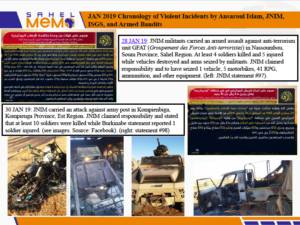PDF REPORT – Burkina Faso: January 2019 SITREP and Chronology of Violent Incidents
- January 2019 witnessed the kidnapping and killing of a Canadian citizen in Yagha Province, Sahel Region. An Italian and Canadian citizen been missing since mid-December and are presumed to have been kidnapped. They were last seen at Bob-Dioulasso, Houet Province, Hauts-Bassins Region. Circumstances of both incidents are different but going forward extreme vigilance is required while traveling in any parts of the country. While no group claimed latter kidnapping, the most likely scenario is that both hostages are handed to JNIM militant brigade and therefore been transferred to Mali. The likelihood of remaining in Burkina Faso is slim.
- January 2019 witnessed one of the worst, if not the worst, act of atrocity against civilians in recent history of Burkina Faso. Reportedly, between December 31 and January 2, Fulani villages were attacked by Koglweogo militiamen in Centre-Nord Region. Notable site of the attacks was Yirgou village but other villages nearby were also reported to have been targeted. Initial report put the number of victims between 50 and 76, however; report by local civil society organization (CSO) on February 1st put the number of casualties to be around 210 and could be more. Furthermore, the same CSO and victims lawyer claimed the attack against Fulani communities in those villages was planned and orchestrated, therefore calling it a “genocide.” Circumstances leading up to Yirgou massacre are unclear and difficult to confirm what exactly happened. However; the incident indicate the connection between acts of militant groups and inter-communal violence. Fulani communities continue to be perceived as backers of militant groups in Burkina Faso, Mali, and Niger. Reportedly, the assassination of a village chief by Ansaroul Islam or Jama’at Nusrat al-Islam wal-Muslimeen (JNIM) was the instigator Yirgou massacre.
- Hauts-Bassins Region was perceived relatively safe compared to the north, however recent weeks witnessed number of incidents. While some incidents appeared to be acts of banditry, others have militant groups signature. This trend likely to continue on the borders with Cote d’Ivoire and Mali in the southwest regions. Important to note that on January 18 at least five young demonstrators killed and eight others injured after clashing with local police at Orodara, Hauts-Bassins Region. Following the event the governor of Hauts-Bassins Region imposed three days curfew in Orodara. Other protests also took place in the region. Tensions between local authorities and population intensified, and exploitation by militant groups should not be ignored.
- On January 26 and following declaration of state of emergency on December 2018 Governor of Boucle du Mouhoun issued order to close for a week all markets and sale points of fuel at multiple locations where militant activities have been recorded. Desperate measures most likely to harm local communities and their livelihoods in addition to already dire humanitarian conditions (see next slide).
- JNIM suffered major setbacks in 2018 after number of its leaders killed by Barkhane in Mali mostly, however; JNIM will continue to pose serious threat and expand in Burkina Faso, Mali, and Niger, thanks to their existing established networks. The group might take time to get re-organized but doesn’t appear to be short of weapons, equipment, or fighters. During January 2019 JNIM claimed responsibility for at least four deadly attacks in Burkina Faso (in addition to others in Mali). Attacks claimed exclusively targeted Burkinabe security forces while incidents of intimidation and against local public service installations were not claimed by neither JNIM or Ansaroul Islam or Islamic State in the Greater Sahara (ISGS). Militants also targeted local entertainment installations (bars for example). With lack of permanent presence of capable security forces both trends will continue and highly likely to expand to other parts of the country.

